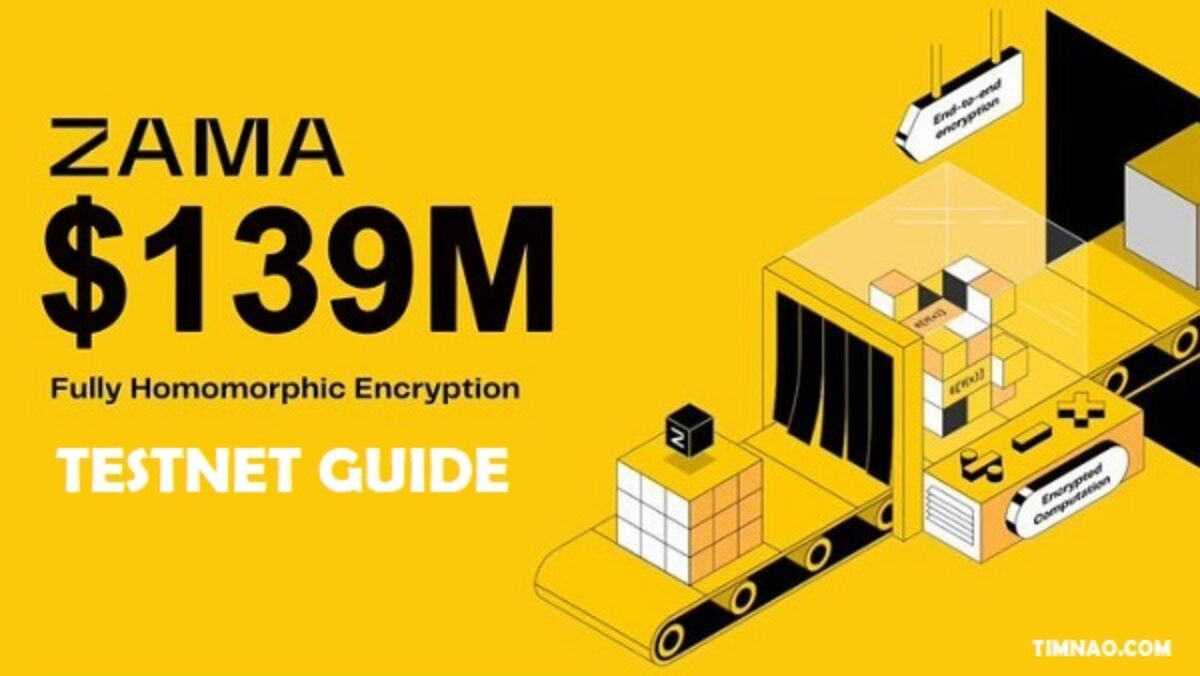
🎉 Powerful New Zama Testnet Guide: Beginners’ Path to Confidential Smart Contracts
Zama testnet is making waves in the blockchain space by unlocking a new era of privacy-first smart contracts. With its groundbreaking use of Fully Homomorphic Encryption (FHE), Zama enables developers to build decentralized applications where data stays encrypted—even during execution. That means more secure transactions, confidential user data, and brand-new possibilities for DeFi, identity, and governance.
Whether you’re a curious developer, an airdrop hunter, or just beginning your journey into Web3, this guide will walk you through exactly how to participate in the Zama testnet. We’ll explain the technology in simple terms, provide hands-on steps, share real-world examples, and help you avoid common beginner mistakes—so you can confidently build the future of encrypted blockchain apps.
Let’s dive in! 👇
Table of Contents
- 🌟 Introduction to Zama testnet and FHE
- 🛠️ Why Zama matters: Privacy is power
- 🧩 How it works: Fully Homomorphic Encryption explained
- 🚀 Step‑by‑step: Getting started with the Zama testnet
- 🧭 Example use cases: Real scenarios for beginners
- 🧪 Developer walkthrough: Building a confidential token
- 🏗️ Tools & libraries: Writing your first private contract
- 🌐 Testnet token drop & ecosystem impact
- 📈 Roadmap: From testnet to mainnet and beyond
- 🧠 Deep insights: Best practices for beginners
- 🔍 Common hurdles and how to overcome them
- 🏁 Wrap-up + next‑steps for new builders
🌟 1. Introduction to Zama testnet and FHE
Zama testnet now opens an exciting world where you can build smart contracts that stay fully encrypted—even while they run on public blockchains. Using advanced fully homomorphic encryption (FHE), Zama enables you to perform computations on hidden data without ever decrypting it. This is a game‑changer for privacy-loving developers and users exploring DeFi, identity solutions, or confidential governance. The public testnet launches July 1, 2025, offering a hands-on way for newcomers to explore encrypted transactions firsthand.
🛠️ 2. Why Zama matters: Privacy is power
Traditional smart contracts expose transaction details for everyone to see. This transparency invites front-running, surveillance, and data leakage—major barriers to broader adoption. Zama changes this by embedding privacy natively. Developers can now build confidential applications on Ethereum, Solana, or EVM-compatible chains without revealing sensitive inputs or contract state.
Highlights:
- Data remains encrypted on-chain, including during execution.
- Public auditability is maintained—only authorized users see specifics.
- Developers define privacy rules right in the contract logic.
This opens up new possibilities: secret stablecoin transfers, blind auctions, private voting, and more. Instead of transparency at any cost, Zama promotes selective sharing, giving developers full control.
🧩 3. How it works: Fully Homomorphic Encryption explained
Fully Homomorphic Encryption (FHE) allows mathematical operations on encrypted data. For instance, if you have encrypted numbers Enc(a) and Enc(b), you can compute Enc(a + b) without revealing a or b. Zama’s breakthrough: integrating FHE into a fully compatible fhEVM, a fork of Ethereum’s EVM.
Tech stack:
- FHE: Traces ensure all computations operate on encrypted values.
- MPC (Multi‑Party Computation): Manages private keys via distributed protocols.
- ZK‑Proofs: Verifies correct encryption of inputs.
- Built for scale: GPU, FPGA, ASIC accelerations bring throughput to 100s or 1,000s TPS with future optimization(zama.ai, zama.ai, zama.ai, defi-planet.com).
Developers write once in Solidity and use fheUint, encrypted integer types, to mark sensitive data. The fhEVM compiles it, ensuring all data remains encrypted until decrypted by authorized off‑chain parties.
🚀 4. Step‑by‑step: Getting started with the Zama testnet
- Register by June 30 at Zama’s public testnet signup page for early access. Link: https://zama.ai/public-testnet
- On July 1, receive your testnet credentials and wallet setup.
- Connect wallets and fund with testnet tokens provided via faucet.
- Explore sample contracts in the Zama documentation and GitHub’s
fhevm-soliditylibrary(github.com, x.com). - Build, deploy, and interact with contracts like private tokens or auctions.
- Learn from community calls and Telegram/Discord Q&A to deepen your knowledge.
🧭 5. Example use cases: Real scenarios for beginners
Let’s dive into practical, beginner-friendly applications you can test today:
- Confidential Tokens: Issue a privacy-preserving stablecoin where balances and transfers are encrypted using
fheUint, but still auditable on-chain(reddit.com). - Blind Auctions: Bidders submit encrypted bids. The highest bid is determined without revealing amounts.
- Private DAO Voting: Votes are encrypted, ensuring privacy while eligible voters verify outcomes.
- Encrypted Identity Verification: Store age, ID hashes, or biometrics in encrypted form to check eligibility without disclosing data(medium.com).
Each example launches with minimal code. Try building one in Solidity by adapting community samples within fhevm-solidity.
🧪 6. Developer walkthrough: Building a confidential token
Here’s a roadmap to build your first encrypted ERC‑20 token:
- Import from GitHub’s
fhevm-soliditylibrary(github.com). - Define balance & transfer using
fheUint. - Use encryption APIs for deposit/withdraw.
- Deploy contract to testnet.
- Interact via frontend scripts that encrypt inputs before sending.
- Monitor encrypted state on-chain—remains unreadable unless decrypted with MPC.
This hands-on guide introduces encryption seamlessly into standard dev workflow.
🏗️ 7. Tools & libraries: Writing your first private contract
Essentials for developers:
- GitHub:
zama-ai/fhevm-solidity– Simplifies encrypted variables and deployment(reddit.com, nftgators.com, github.com). - Zama docs – Detailed tutorials, from confidential tokens to async decryption(zama.ai).
- Community channels – Active on Telegram, Discord, GitHub Discussions. Expect live help with newbies in early July.
- Video tutorials – Walkthroughs by team members like Clément Danjou and Joseph‑Andre Turk make learning easy(zama.ai).
🌐 8. Testnet token drop & ecosystem impact
Early registrants receive testnet tokens and qualify for potential future airdrops—a significant draw in DeFi. Zama’s public launch event coincides with July 1, coinciding with heavy buzz across the industry(x.com).
Securing early tokens can grant you benefits once mainnet launches and the $ZAMA token is released. It also gives you a chance to test, break, and improve your contract before going live.
📈 9. Roadmap: From testnet to mainnet and beyond
- Q3–Q4 2025: Mainnet debut on Ethereum, followed by EVM-compatible chains and Solana(blog.jucoin.com, zama.ai).
- Token launch: $ZAMA tokens will fuel the ecosystem.
- Performance: Early testnet supports ~20 TPS; target is 1K+ TPS with hardware scaling.
- Ecosystem growth: Developer toolkits, bounties, partnerships across DeFi, identity, and privacy projects.
🧠 10. Deep insights: Best practices for beginners
- Start small: Begin with simple confidential contracts before scaling complexity.
- Understand encryption flows: Learn how data moves encrypted and how decryption works off-chain.
- Get interactive: Join Discord and Telegram. Ask questions and share code.
- Use encryption test tools: Validate input encryption before deployment.
- Leverage examples: Modify existing GitHub samples instead of building from scratch.
- Learn about cost: FHE has compute overhead—optimize gas and testnet interactions accordingly.
🔍 11. Common hurdles and how to overcome them
Performance overhead: FHE is heavier than plaintext computation. Start with low-volume use cases and scale gradually. GPU-based testnet support helps mitigate latency.
Key management: Zama uses MPC to split decryption keys. Understand who manages keys in your contracts and how threshold decryption works.
Debugging encrypted output: You can’t directly read values. Use testing scripts and debug contracts with pre- and post-decryption checkpoints.
Gas consumption: Encrypted logic can push gas limits. Deploy to testnet first, gauge costs, optimize code for real mainnet use.
🏁 12. Wrap‑up + next‑steps for new builders
Zama testnet is a rare opportunity to explore confidential smart contracts ahead of the curve. With privacy baked in, you can build tokens, auctions, voting systems, or identity frameworks—all encrypted and auditable.
✅ Your immediate next steps:
- Register by June 30 for testnet access.
- Explore GitHub samples and tutorials.
- Join community channels for live support.
- Build a simple contract like an encrypted token.
- Share your work, gather feedback, and shine in early airdrop rounds.
Zama brings privacy to public blockchains—and you’re invited to build the future. Dive in early, learn fast, and empower confidential innovation.
